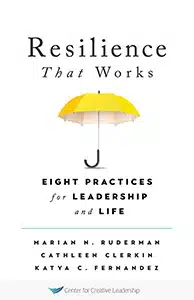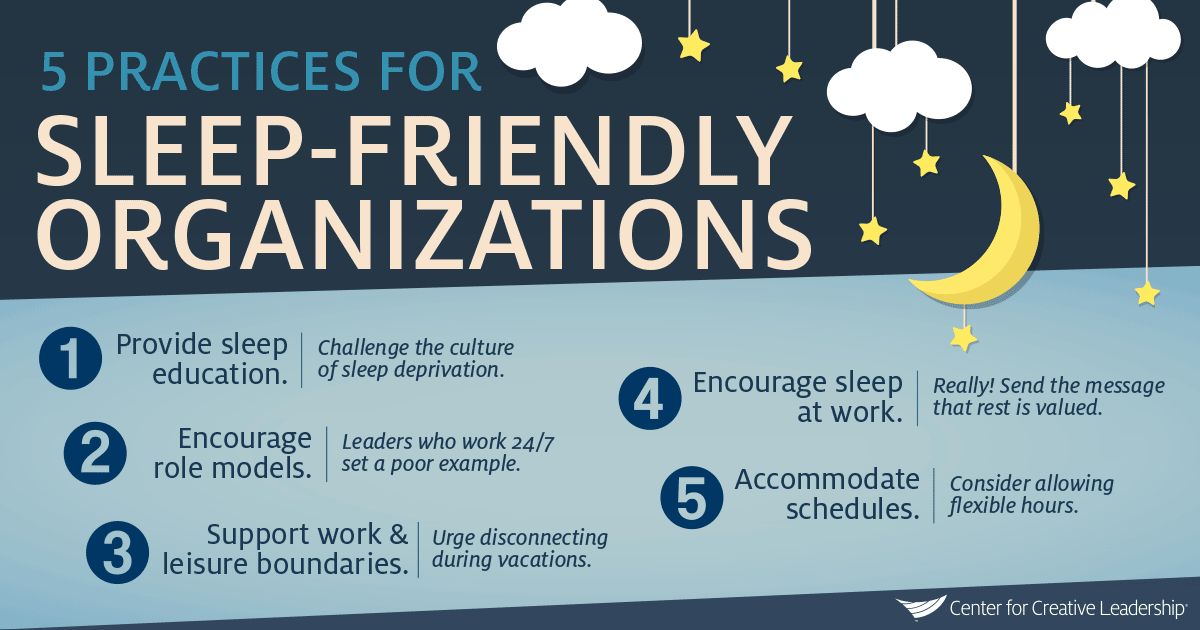What if leaders were well-rested?
Many executives and leaders are getting by on very little rest, and see no way around it. Even before the global pandemic, in a hyper-connected culture, managers were trying to squeeze out more and more from themselves and others, pushing for productivity, looking for an edge.
Now, with leaders struggling to cope with pandemic stress and burnout at an all-time high, organizations — and individuals — are suffering.
When it seems there are not enough hours in the day, something has to give, and often, it’s sleep.
But sleep is not a luxury.
The Connection Between Sleep and Work Performance
Sleeping less reduces brainpower, productivity, and the ability to communicate. It also diminishes concentration, lowers creativity, and impairs memory, motor, and people skills.
At a very simple level, 2 important things take place when you get a good night’s sleep:
- The sleeping brain processes and organizes information.
- The sleeping brain helps the body’s stress response switch off.
These 2 functions, in turn, have an effect on memory, decision-making, attitudes, innovation, and creativity throughout the whole day.
If leaders are well-rested, they function at their best with better memories and stronger skills for making new and creative connections. They regulate emotions and engage with others more effectively. Stress decreases. The complexity of leading will be matched by the capability to respond with clarity, creativity, and productivity.
Our research about being tired at work makes the case that senior leaders — and everyone else working in challenging, complex situations — need to get more sleep.
Lost sleep triggers moodiness, increases pressure and anxiety, and is related to a variety of serious health problems and increased healthcare costs.
Since a lack of sleep hinders leadership performance, it can put your organization at risk as a result. A recent study concluded that fatigue-related productivity losses cost an estimated $1,967 per employee annually.
A sleep-deprived workforce can cause significant damage to the organization. In the long term, it’s equally dangerous to the individual — according to the Centers for Disease Control (CDC), deficiencies in rest are linked to high blood pressure, heart disease, and diabetes.
Bottom line: Managers, executives, and many others are working long and hard, dealing with complex issues and facing unknown challenges. Not sleeping enough limits the ability to respond to complex organizational challenges, and a lack of sleep hinders productivity.

Dive deeper into 8 practices that keep you healthy, focused, and functioning with our book, Resilience That Works: Eight Practices for Leadership and Life.
Improve Sleep, Improve Work Performance
Organizations Play a Role in Helping Leaders Get Better Sleep
Although sleep is a personal and individual matter, clearly workplace issues and organizational culture are affecting how people sleep. Plus, organizations suffer the costs of sleep deprivation.
Many leaders we’ve worked with have voiced their concerns about their own fatigue and exhaustion and the way it relates to the unspoken cultural norms in their workplace. One leader in our research survey on sleep and leadership told us, “Around me, I see too many people blitzed by long hours, stressful commutes, jet lag, poor diet, lack of exercise, and working while on holiday.” Many leaders report burning the candle late into the night and in the early morning hours, sacrificing rest to fit more in the day.
The expectation to burn the candle at both ends can often be linked to the culture within an organization and the messages that are intentionally or unintentionally communicated throughout. That’s why it’s critical for organizations to take steps to improve the sleep-health of its workforce.
5 Practices for Sleep-Friendly Workplaces
Many organizations, such as PricewaterhouseCoopers, Google, NASA, and Ben & Jerry’s, have integrated healthy sleep practices. As outlined in our white paper, here are 5 practices organizations can implement to become more sleep-friendly and support both better sleep and productivity:
1. Provide sleep education.
Create a “sleeping awareness” program or campaign to challenge the cultural notion that sleep is a waste of time or a weakness. The effort could stand on its own, or be a component of an employee wellness program or larger development initiative.
- Introduce the idea that more work isn’t better work. Look for ways to question practices and assumptions that value hours worked more than impact and results. Let people know that when they are tired, they’re less effective as leaders and managers. Encourage them to view sleep as a simple, easy, and cheap way to boost productivity and be more effective.
- Share the science — people like to know that there’s evidence behind this recommendation. Share articles, tips, quizzes, and helpful links via existing employee communications channels.
- Acknowledge the reality that people are overextended at work and in other areas of life. One leader cannot change this on your own or overnight, but you can play an important role in shifting the culture.
2. Encourage role models to push back on the 24/7 culture.
Enlist senior executives to support your efforts, helping to communicate the message that sleep supports the performance and wellbeing of leaders and the organization as a whole.
- Ensure leaders model desired behaviors. For example, they should avoid discussing waking up at 4 a.m. to begin work or sending emails in the late hours of the night or over the weekend. This negatively influences organizational culture and sets unhealthy expectations for others.
- Meet with managers whose teams are especially prone to long hours or travel. Help them understand the value of sleeping more for themselves. Encourage them to tout sleep as a way to be more effective and support their employees in getting more rest.
- Encourage senior leaders to bring up the sleep challenges that teams face and discuss possible solutions in routine meetings or trainings. Leaders can be transparent about their own choices to get more rest: sharing that they declined a late dinner after a day of travel so that they could be well-rested for an important morning presentation, for example. Candidly bringing up the issue and creating space for teams to discuss it openly creates and reinforces greater psychological safety at work.
3. Support boundaries between time for work and time for leisure.
Factor sleep into policies and schedules. Alongside the culture and awareness messages, take a look at organizational policies and norms that may discourage rest and recovery time.
- Allow for transition time between home and work. Review schedules, break times, and limits to hours or shifts. Encourage employees to make time for wellness.
- Support employee unavailability during vacations. Put the spotlight on outcomes and impact, rather than hours worked, and emphasize the value of really “unplugging.”
4. Encourage sleep at work. Really!
Forget the notion of “don’t sleep on the job.” Instead, send the message that sleep is truly valued and leads to optimal performance at work.
- Provide nap rooms, energy pods, and comfortable chairs in your workspaces. This reinforces that your organization is serious about creating space for rest.
- Educate employees about how best to leverage such resources. Just providing a nap room isn’t enough. Communicating about the available resources is also important. If you don’t actively encourage employees to take advantage, you’ll likely find such resources unused!
5. Accommodate schedules.
When possible and practical, consider offering flexible hours and telecommuting to allow employees to work when they’re most likely to function at their best.
- Consider time off after travel, and work with teams or departments to set norms for availability across time zones and technology or accessibility expectations. This is especially important for leaders who are managing remote employees.
- Let departments pick a week each month to power down and get more rest — some of the habits may stick, and positive changes may catch on and cascade throughout the organization.
Your company’s focus on supporting your people in improving sleep and work performance will help to build a healthier organizational culture and will improve employee engagement and retention.
Ready to Take the Next Step?
It’s important to foster a culture where your people understand the connection between sleep and work performance and create a culture that values sleep, recovery, and other resilience practices. Our resilience-building solutions will help your leaders avoid burnout — and burn bright instead.









